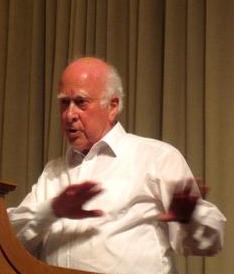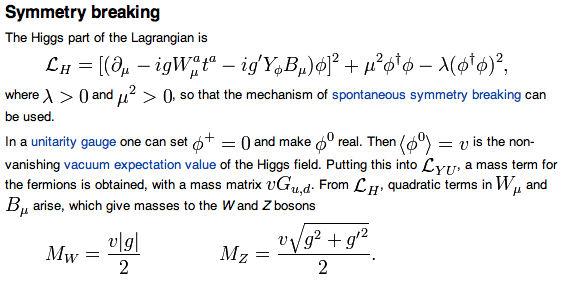Marco Franceschini e Simone Osto , VC, ci spiegano la scoperta di quella “benedetta” particella (“God particle”).
The 2013 Nobel prizes in Physics: Higgs and Englert (by Marco Franceschini, 5C)
 On the 8th October 2013, Peter Higgs and François Englert were awarded with the Physics Nobel prize «or the theoretical discovery of a mechanism that contributes to our understanding of the origin of mass of subatomic particles, and which recently was confirmed through the discovery of the predicted fundamental particle, by the ATLAS and CMS experiments at CERN’s Large Hadron Collider».
On the 8th October 2013, Peter Higgs and François Englert were awarded with the Physics Nobel prize «or the theoretical discovery of a mechanism that contributes to our understanding of the origin of mass of subatomic particles, and which recently was confirmed through the discovery of the predicted fundamental particle, by the ATLAS and CMS experiments at CERN’s Large Hadron Collider».
This means that Mr Peter Higgs from the University of Edinburgh and Mr François Englert, from the University of Brussels shared the prize, received at Stockholm in Sweden from the Royal Swedish Academy of Sciences.
What Higgs and Englert theorized was the Higgs Boson, an elementary particle that generates a field (the Higgs Field) in which the quarks obtain mass and, accordingly to this, everything obtains it. If the Higgs Field did not exist, the world would be very different from the world we actually know. By the way, even if the Field and the Boson owe their name to the British physicist, Peter Higgs, this does not mean that the Belgian physicist has no credit in the theorization, which happened at the same time in 1964.
The Higgs Boson is also known as “God particle”, which derives from the misunderstanding of the original name, due to the difficulties found to observe it, which became that “goddamn particle”!
Even though the theory by Higgs and Englert was plausible from the very first moment, no one in the scientific world believed in it. In fact, Stephen Hawking, the world’s greatest cosmologist, bet 100£, sure he was going to win, on the non-existence of the Higgs Boson. Obviously he lost, because in on July 2012 ATLAS and CMS experiments at CERN Large Hadron Collider (which is a place where protons are made colliding), showed tracks of the decaying process of something which owned the features of the Higgs Boson as Peter Higgs had predicted, and so they could say that the Higgs Boson did exist.
This means that the Standard Model, that is the model of Quantum Physics, which describes the universe and its birth, has been proved in almost all of its parts. The very last part that remains is the discovering of the Graviton, the mediator of the gravitation, which is still hypothetical, but we do not need to hurry. If the Higgs Boson needed almost 50 years to be proved, we must be confident in the new experiments, which are occurring worldwide.
Higgs Boson: the work of more than a thousand physicists (by Simone Osto, 5C)
 The Higgs boson is an elementary particle, which is not composed of other smaller particles. But how does the Higgs boson (called by the media “the God particle”) actually work? At the time of Big Bang, a sort of super-energetic tiny particles huddled in every drop of space-time. As the drops were expanding they cooled down, so the particles lost energy. “Mass” did not exist yet. Shortly after Big Bang, as soon as temperature dropped just a little, the whole universe was suddenly permeated by a field, a presence that materialized out of nothing: just like water suddenly turning into ice. This field, which physicists call “Higgs field”, had an incredible effect on elementary particles that, until that moment, moved at the speed of light. Some of them, in fact, did the crossing without any impediment, while others dragged along with greater difficulty, slowing down their speed. Some of the energy of the particles was converted into something else. Einstein demonstrated that it is possible to convert energy into mass, and Higgs field gave mass to particles. Quantum physicists imagine that Higgs field is made of tiny particles that transmit the effect of the field and they are called Higgs bosons. Higgs field is not immobile, its movements are caused by Higgs bosons that appear and disappear.
The Higgs boson is an elementary particle, which is not composed of other smaller particles. But how does the Higgs boson (called by the media “the God particle”) actually work? At the time of Big Bang, a sort of super-energetic tiny particles huddled in every drop of space-time. As the drops were expanding they cooled down, so the particles lost energy. “Mass” did not exist yet. Shortly after Big Bang, as soon as temperature dropped just a little, the whole universe was suddenly permeated by a field, a presence that materialized out of nothing: just like water suddenly turning into ice. This field, which physicists call “Higgs field”, had an incredible effect on elementary particles that, until that moment, moved at the speed of light. Some of them, in fact, did the crossing without any impediment, while others dragged along with greater difficulty, slowing down their speed. Some of the energy of the particles was converted into something else. Einstein demonstrated that it is possible to convert energy into mass, and Higgs field gave mass to particles. Quantum physicists imagine that Higgs field is made of tiny particles that transmit the effect of the field and they are called Higgs bosons. Higgs field is not immobile, its movements are caused by Higgs bosons that appear and disappear.
The result is a space in which particles push each other. When an electron, for example, enters this field, it easily crosses this space. Other particles, however, are slowed down more by bosons and by slowing down, convert much energy into mass. The more particles slow down because of Higgs field, the more energy will be condensed into a super-concentrated form, that we call mass.
It took almost half a century to prove Higgs’s theoretical prediction of 1964 and the work of more than a thousand physicists, in addition to the construction of the largest and most expensive scientific instrument ever built, the Large Hadron Collider (LHC) accelerator at CERN (European Centre for Nuclear Research), which is in a tunnel 27 kilometres. Italian physicists also participated in the experiment in which Higgs boson was found in a range of energy with a probability of 99%. Even though this value was certainly considerable, the scientific community asked that before being formally able to announce a discovery, the physicists should reach a probability level of 99,99994%.
The Higgs boson was observed for the first time in 2012, in some experiments with the LHC and its discovery was officially confirmed on March 6, 2013 during a conference, which took place in La Thuile by physicists at CERN. The data relating to its characteristics are, however, still incomplete. The Large Hadron Collider has been turned off earlier this year and it is expected to remain inactive until 2015 for important work on safety devices. The Higgs boson is known to the general public and the media with the name of “God Particle”, derived from the title of physics book by Leon Lederman The God Particle: If the Universe Is the Answer, What Is the Question? The work was published in 1993. Higgs said he did not approve of this expression, finding it potentially offensive to religious people. Later, in an interview with The Telegraph, he felt that it would lead off road because he professes an atheist, saying that it was a joke.